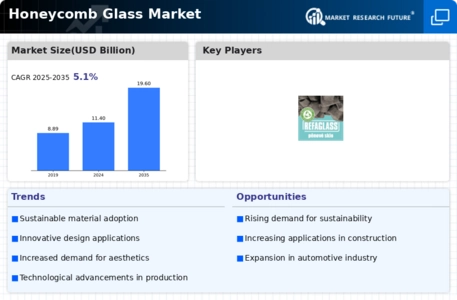Top Industry Leaders in the Honeycomb Glass Market

Honeycomb glass, a lightweight, high-strength material with exceptional thermal insulation properties, is carving its niche in diverse industries. Its unique honeycomb structure, featuring closed cells filled with air, offers a potent combination of strength, thermal efficiency, and fire resistance. This has sparked a dynamic competitive landscape within the market, with established players and emerging startups vying for market share.
Strategies Adopted by Honeycomb Glass Leaders:
-
Product Diversification: Major players like Pittsburgh Corning and GLAPOR are expanding their portfolios beyond traditional black foam glass to include white foam glass and even multi-colored options for architectural applications. This caters to diverse aesthetic and functional needs. -
Technological Innovation: Companies are actively investing in R&D to enhance the performance and applications of honeycomb glass. Examples include Hexcel Corp.'s collaboration with Metyx Composites to develop high-performance pultruded carbon fiber profiles using honeycomb glass for wind energy applications. -
Regional Expansion: Established players are entering new markets like China and India, driven by the rapid growth in these regions' construction and infrastructure sectors. This is exemplified by REFAGLASS's recent expansion into China through a joint venture with a local company. -
Sustainability Focus: Environmental concerns are driving the development of eco-friendly honeycomb glass solutions. Earthstone, for instance, utilizes recycled glass content in its products, while Zhejiang DEHO emphasizes energy-efficient manufacturing processes. -
Strategic Partnerships and Collaborations: Companies are forging partnerships to leverage each other's strengths and access new markets. This is evident in Hasopor AB's acquisition of Uusioaines Oy, solidifying its position as the leading foam glass manufacturer in Europe.
Factors Influencing Market Share:
-
Cost-Effectiveness: Honeycomb glass, though initially more expensive than traditional materials, offers significant long-term cost savings through improved energy efficiency and reduced maintenance requirements. This factor is becoming increasingly important in energy-conscious markets. -
Government Regulations: Stringent building codes and regulations advocating for energy-efficient materials are driving demand for honeycomb glass in the construction sector. For instance, the adoption of stricter energy efficiency standards in Europe is expected to boost the market in the region. -
Application Diversification: The expanding range of applications for honeycomb glass, from cryogenic systems to building insulation and even aerospace components, is opening up new avenues for market growth. -
Technological Advancements: Advances in manufacturing processes and material science are leading to the development of lighter, stronger, and more versatile honeycomb glass products, further enhancing its appeal across various industries.
Key Companies in the Honeycomb Glass Market include
- Pittsburgh Corning
- GLAPOR
- Earthstone
- JSC Gomelglass
- REFAGLASS
- Zhejiang DEHO
- Huichang New Material
Recent News
-
August 2023: JSC Gomelglass, a Belarusian manufacturer, announced a new line of high-strength honeycomb glass panels for shipbuilding and offshore platforms. -
September 2023: The U.S. Department of Energy awarded a grant to develop next-generation honeycomb glass for cryogenic applications in advanced space exploration missions. -
October 2023: The European Union proposed stricter regulations on the use of hazardous chemicals in the production of honeycomb glass, prompting manufacturers to adopt more sustainable practices. -
November 2023: A consortium of leading honeycomb glass manufacturers launched a joint research initiative to develop standardized testing procedures for the material.

